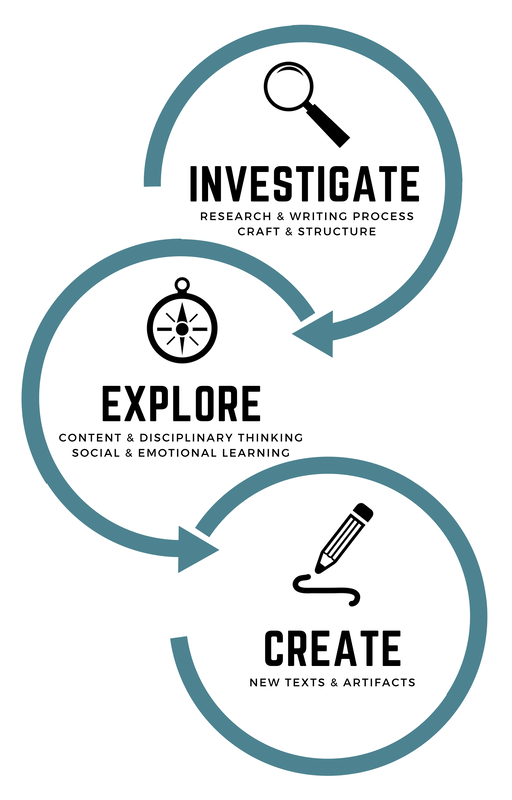About Our Work
Below, you’ll find a guide for reading our Biography Clearinghouse entries. We follow the same format in each entry, but different books may emphasize different types of learning experiences. What you’ll find in one of our entries is not a complete unit plan or even a complete lesson plan. We know that as the classroom teacher or school librarian, you’re the best one to create those structures.
What we aspire to do with our entries is to support your planning. We think biographies can and should be used across the content areas and throughout the year. Ideally, you’ll find our teaching ideas invitations for using biographies with your students in new and interesting ways.
At the beginning of each entry, we’ll always tell you the basic information about a book, including the publisher and the available formats.
Next, you’ll see the following structures. These are directly connected to our Principles and Frameworks document.
What we aspire to do with our entries is to support your planning. We think biographies can and should be used across the content areas and throughout the year. Ideally, you’ll find our teaching ideas invitations for using biographies with your students in new and interesting ways.
At the beginning of each entry, we’ll always tell you the basic information about a book, including the publisher and the available formats.
Next, you’ll see the following structures. These are directly connected to our Principles and Frameworks document.
Investigate the TextThis section focuses on the process and craft of creating biography. It includes teaching invitations that engage students with a close study of the craft of biography. It also includes interactions with the author/illustrator through interviews, process documents, and author/illustrator websites.
Research & Writing ProcessThis section will include links to an interview with the author/ illustrator and links to process documents provided by the author/ illustrator.
Craft & StructureQuestions that focus attention on craft and structure deal with the word choices, writing style, evidence of accuracy, visual information provided, and organization. Examining these features helps readers understand the unique way that authors and illustrators construct nonfiction.
|
Explore the World
This section contains teaching invitations, descriptions of learning activities and associated resources that support students to use the biography as a launching point for learning about history, historical thinking, and humanity. The teaching invitations are descriptive rather than prescriptive, describing the goals of the activity, student work products, and providing links to multimodal multigenre resources.
Content & Disciplinary Thinking
Biographies provide content for readers to think about. Some of this content is information that you might need or want to explore in your science and social studies classes. Disciplinary literacy can be described as the ways in which people in different fields think, read, write, and talk. Biographies introduce readers to the way biographers and historians think about content. Biographies also reveal the disciplinary literacies of particular fields as they show scientists, artists, inventors, leaders, and more taking action in the world.
In this section, you will read about teaching ideas that allow students to consider information, multiple perspectives, the historical significance of events, historical evidence, continuity and change over time, cause and effect, and the lessons of history. Teaching ideas may highlight the sociohistorical context in which the subject of a biography lived their life. Primary sources may be shared to help you and your students understand that context. Themes may also be explored.
In this section, you will read about teaching ideas that allow students to consider information, multiple perspectives, the historical significance of events, historical evidence, continuity and change over time, cause and effect, and the lessons of history. Teaching ideas may highlight the sociohistorical context in which the subject of a biography lived their life. Primary sources may be shared to help you and your students understand that context. Themes may also be explored.
Socio-Emotional Learning
Biographies provide important opportunities for students to explore the character traits of real people. Teaching ideas may ask you and your students to consider subjects’ motivations and passions, the ways in which the subject was an agent of change, the turning points in a subject’s life, and the ways in which the subject identified with a specific community or communities.
Create New Texts & Artifacts
This section focuses on student’s creating new written texts, works of art, performances, etc. in response to the biography and the teaching invitations included in the sections above. This could include writing original biographies. Writing biography enables readers to experience the process of writing about the past by (1) selecting and using evidence and (2) trying out the processes followed by authors and illustrators. But it can also include applying specific research or writing strategies to other genres, or working off of the illustrations to create new art, or creating and conducting scientific experiments inspired by the subjects.
A Note about Language
We purposefully use the term “picturebook” as one word here based on Larry Sipe’s (1998) conceptualizations of the text-picture relationships in children’s literature. Sipe argued that the terms “picture” and “book” should be combined because readers use both images and text simultaneously; illustrations and text have a synergistic relationship and, thus, should not be separated from one another.


